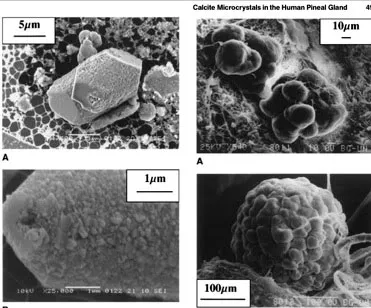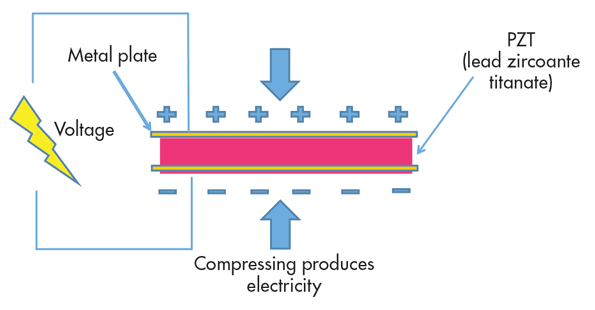'A new form of biomineralization found In the pineal gland'...
Distinct from the 'mulberry-type hydroxyapatite concretions'...

In 2002, researchers discovered a new hexagonal microcrystal less than 20 microm in length. With energy dispersive spectroscopy they determined it was composed of calcium, carbon and oxygen.
The only other nonpathological calcite occurence is the otoconia structure of the inner ear.
Otoconia - small crystals of calcium carbonate in the saccule and utricle of the ear that under the influence of acceleration in a straight line cause stimulation of the hair cells by their movement relative to the gelatinous supporting substrate containing the embedded cilia of the hair cells. (https://www.merriam-webster.com/medical/otoconia)
Now it is speculated that these calcite microcrystals are responsible for the second harmonic generation in pineal tissue sections.
Second harmonic generation - (also called frequency doubling or SHG) is a nonlinear optical process in which two photons with the same frequency interact with a nonlinear material, are "combined", and generate a new photon with twice the energy of the initial photons (equivalently, twice the frequency and half the wavelength). It is a special case of sum frequency generation. Wikipedia.org
As with the otoconia, the complex texture of the microcrystals could possibly have a piezoelectric effect.

Piezoelectricity - is the electric charge that accumulates in certain solid materials (such as crystals, certain ceramics, and biological matter such as bone, DNA and various proteins)[1] in response to applied mechanical stress. Wikipedia.org
Again, this structure is different from the fluoride deposits and hydroxyapatite concretions.
'Fluoride Deposition in the Aged Human Pineal Gland'
'A preliminary study of human pineal gland concretions: structural and chemical analysis.'

With this discovery, it prompted researchers to consider the effect of electromagnetic fields on the pineal gland, which is responsible for regulating our circadian rhythm.
The International Agency for Research on Cancer (IARC) classifies electromagnetic fields (EMFs) as 'possibly carcinogenic' to humans that might transform normal cells into cancer cells. Owing to high utilisation of electricity in day-to-day life, exposure to power-frequency (50 or 60 Hz) EMFs is unavoidable. Melatonin is a natural hormone produced by pineal gland activity in the brain that regulates the body's sleep-wake cycle. How man-made EMFs may influence the pineal gland is still unsolved. The pineal gland is likely to sense EMFs as light but, as a consequence, may decrease the melatonin production.
This study was only based on weak EMF's but isn't everyone excited for that 5G?
My previous post on the Pineal Gland: 'What Is The Pineal Gland? Did You Know You Have A Mysterious, Biologic 'Third Eye'?'
As always, let me know what you guys think! And God bless!
http://www.next-up.org/pdf/StudyBioelectromagneticsCalcitePinealGlandHumainBrainDrGrahameBlackwel.pdf
https://www.ncbi.nlm.nih.gov/pubmed/12224052
https://www.ncbi.nlm.nih.gov/m/pubmed/8381851/
https://www.ncbi.nlm.nih.gov/pubmed/23051584

🐦 TWITTER @newtreehints
🎬 DTUBE @newtreehints
📷 NSTGRM @newtreehints